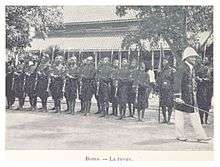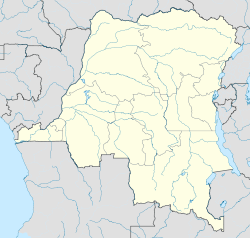Batetela rebellion

The Batetela rebellion[lower-alpha 1] (French: Révolte des Batetela) was a series of three military mutinies and a subsequent low-level insurgency which was attributed to members of the Tetela ethnic group in the Congo Free State between 1895 and 1908.[1] Beginning in a mutiny among the troops the Force Publique of Luluabourg (modern-day Kananga) in January 1895, the revolt sparked an prolonged insurgency and two further mutinies elsewhere in the Congo. The rebellion was one of the most important anti-colonial rebellions in the history of the Congo and the last Tetela rebels were only defeated in 1908.
Mutinies


The Batetela rebellion usually refers to three separate military mutinies in the Force Publique:
- 1895: mutiny in the garrison of Luluabourg (modern-day Kananga);[2]
- 1897: mutiny among the troops under Francis Dhanis on an expedition to the Upper Nile;[2]
- 1900: mutiny among the garrison of Fort de Shinkakasa near Boma.[2]
The Force Publique recruited heavily from the Tetela ethnic group in the Sankuru, Maniema and Lomami regions, especially during the Congo Arab War (1892–94).[3] In January 1895, the garrison of Luluabourg mutinied in response to the execution of the warlord Gongo Lutete for treachery during the war against the Arabs.[3] In October 1896, there were approximately 3–4,000 Batetela rebels.[4] The mutineers killed one of their white officers and escaped, being joined by Tetela soldiers from across the colony over the coming years.[3] In 1897, 1,300 troops from the Tetela and Kusu ethnic groups in an expeditionary force sent to the Upper Nile under the command of Baron Francis Dhanis mutinied, complaining of poor treatment.[3] The force, the largest military force assembled in colonial Africa up to that point, had been sent to annex the Fashoda region in modern-day South Sudan and the expedition's collapse as a result of the mutiny meant that the Congo Free State would ultimately avoid becoming a party in the Fashoda Incident. The mutineers killed 10 Belgian officers and took a French priest hostage.[5] He was released unharmed.[6]
The third rebellion broke out in the garrison of the Shinkakasa fort on the Congo River on 17 April 1900. The rebels gained control of the fort and opened fire on a moored ship and threatened the safety of the colonial capital, Boma.[3] Despite being repeatedly defeated, the last Tetela mutineers held out around Lake Kisale until 1908.[7][4]
Notes and references
Footnotes
- ↑ In most Bantu languages, the prefix ba- is added to a human noun to form a plural. As such, Batetela refers collectively to members of the Tetela ethnic group.
References
- ↑ Gann & Duignan 1979, pp. 78–9.
- 1 2 3 Crawford Young 1965, p. 441.
- 1 2 3 4 5 Gann & Duignan 1979, p. 78.
- 1 2 Renton, Seddon & Zeilig 2007, p. 34.
- ↑ Legum 1961, p. 111.
- ↑ Legum 1961, p. 112.
- ↑ Gann & Duignan 1979, p. 79.
Bibliography
- Crawford Young, M. (1965). Politics in Congo: Decolonization and Independence. Oxford: Oxford University Press.
- Gann, Lewis H.; Duignan, Peter (1979). The Rulers of Belgian Africa, 1884–1914. Princeton: Princeton University Press. ISBN 9780691052779.
- Legum, Colin (1961). Congo Disaster. Penguin.
- Renton, David; Seddon, David; Zeilig, Leo (2007). The Congo: Plunder and Resistance. London: Zed Books. ISBN 978-1-84277-485-4.
Further reading
- Pakenham, Thomas (1992). The Scramble for Africa: the White Man's Conquest of the Dark Continent from 1876 to 1912 (13th ed.). London: Abacus. ISBN 978-0-349-10449-2.